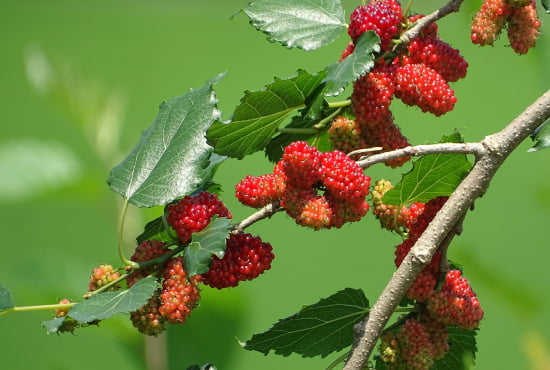Introduction Of Mulberry
Why should you be interested in the mulberry? The answer to this question could be many, such as its long history of use, or its amazing nutritional and medical benefits. Let’s take a look at the mulberry from top to bottom, and see what it has to offer us!
Before you delve into mulberry’s best uses and amazing facts, it helps to know a few basics. Mulberries are a summer fruit that grows on large trees with spreading branches. These berries may be white, red, or black depending on the variety. Mulberries have been used in traditional Chinese medicine for centuries and are believed to help boost energy levels. In India and some parts of China, mulberries are considered an aphrodisiac—though the proof is scant at best. As a food source, mulberries are eaten fresh or used as an ingredient in pies, jams, and wine. What’s more?

Special Character
Mulberries are known to be one of the most effective and popular healing foods. People often look forward to eating mulberries in desserts or blending them into smoothies. The delicate sweetness and exquisite flavor have always made these berries a hit with people of all ages. But if you know how beneficial they are for your body and health, you’ll surely be compelled to add them to your everyday diet as well.
How To Grow Mulberries
Mulberries grow best in zones 5 through 8, and it is recommended that they be planted in full sun. Mulberries thrive on a well-drained soil and they produce best when they are fertilized once or twice a year with an organic fertilizer. Mulberries prefer to have ample moisture and should be watered every few days if rainfall is limited.
Your mulberry plant will not survive frost damage; so make sure you plant your mulberry where it can endure cold temperatures. When planting a new mulberry tree, you will want to dig a hole approximately four times as deep as your roots. If you are planting more than one tree, make sure that each tree has plenty of room between them to grow without competition for water or sunlight.

Caring For Mulberry Plant
Mulberries should be planted in early spring when they can benefit from a long growing season. They need to grow slowly, so mulch them well and water them sparingly until they’re established. After that, mulberries don’t need much care to thrive. If left alone they will often spread through suckers and create dense thickets of berries.
Mulberries do best when grown in acidic soil with good drainage and prefer full sun but also tolerate light shade or partial sun very well too. This plant is easy to grow even if you are new at gardening or have had bad luck with plants in past. So give it a try!
Mulberries are native to China, Korea, and Japan. The trees produce large berries that have a sweet yet tangy flavor. Mulberries have long been cultivated in these areas of Asia because they grow best in mountain regions. They can tolerate cold temperatures better than most other fruit trees and they do not require much water or maintenance.
Plants will grow well in a variety of soil types as long as it is well-drained and free from heavy metals such as lead or mercury. If you intend to grow your mulberry tree indoors make sure you use a container with good drainage holes at the bottom or plant it directly into well-drained soil that is enriched with compost to give it plenty of nutrients for optimum growth.

Health Benefits Of Mulberries
Recent studies have shown that mulberries contain a significant amount of antioxidants and phytochemicals which protect us from chronic diseases. They are a great source of magnesium as well as Vitamins B1 and B6. Mulberries contain a protein called sporamin which is known to help prevent cardiovascular disease.
These berries can also help with weight loss due to their fiber content. The great thing about mulberries is that they are available in fresh or dried forms so you can easily incorporate them into your diet no matter what form you choose for consumption.
The dried form of these berries can be eaten raw or added to drinks like smoothies whereas eating them raw requires you to blend them with other fruits for better flavor and texture.

